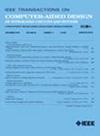A Recursive Partition-Based In-Memory SIMD Computation Scheduler for Memory Footprint Minimization
IF 2.7
3区 计算机科学
Q2 COMPUTER SCIENCE, HARDWARE & ARCHITECTURE
IEEE Transactions on Computer-Aided Design of Integrated Circuits and Systems
Pub Date : 2024-12-04
DOI:10.1109/TCAD.2024.3511337
引用次数: 0
Abstract
In-memory computing (IMC) is a technique that enables memory to perform computation so that data transfer between processor and memory can be reduced, improving energy efficiency. A popular IMC design style is based on the single-instruction-multiple-data (SIMD) concept. The SIMD IMC can implement a high-level function by two steps: 1) synthesis and 2) scheduling. The former converts the high-level function into a netlist of the supported primitive logic operations, while the latter determines the execution sequence of the operations. To fully exploit the advantage of SIMD IMC, it is crucial to find a schedule for the given netlist with less memory usage, known as memory footprint (MF). In this work, we first propose an optimal scheduler that can minimize the MF for small netlists. It is at least一个基于递归分区的内存SIMD计算调度器,用于内存占用最小化
内存计算(IMC)是一种使内存能够执行计算的技术,从而减少处理器和内存之间的数据传输,从而提高能源效率。流行的IMC设计风格基于单指令多数据(SIMD)概念。SIMD IMC可以通过两个步骤实现高级功能:1)合成和2)调度。前者将高级函数转换为支持的基本逻辑操作的网络列表,而后者决定操作的执行顺序。为了充分利用SIMD IMC的优势,为给定的网络列表找到一个内存使用较少的调度(称为内存占用(memory footprint, MF))是至关重要的。在这项工作中,我们首先提出了一个最优调度程序,可以最小化小网络列表的MF。它比最先进的最优方法至少快8倍。对于大型网络列表,我们提出了一个基于递归分区的调度程序,该调度程序由调度友好的双分区算法和我们的最优调度程序组成。与四种最先进的启发式方法相比,在相同的运行时间下,我们的方法分别将MF降低了54.7%,48.9%,44.0%和25.5%。我们的实验还表明,当应用于各种IMC体系结构时,我们的调度器实现了良好的端到端性能。我们的调度程序的代码是开源的。
本文章由计算机程序翻译,如有差异,请以英文原文为准。
求助全文
约1分钟内获得全文
求助全文
来源期刊
CiteScore
5.60
自引率
13.80%
发文量
500
审稿时长
7 months
期刊介绍:
The purpose of this Transactions is to publish papers of interest to individuals in the area of computer-aided design of integrated circuits and systems composed of analog, digital, mixed-signal, optical, or microwave components. The aids include methods, models, algorithms, and man-machine interfaces for system-level, physical and logical design including: planning, synthesis, partitioning, modeling, simulation, layout, verification, testing, hardware-software co-design and documentation of integrated circuit and system designs of all complexities. Design tools and techniques for evaluating and designing integrated circuits and systems for metrics such as performance, power, reliability, testability, and security are a focus.

 求助内容:
求助内容: 应助结果提醒方式:
应助结果提醒方式:


